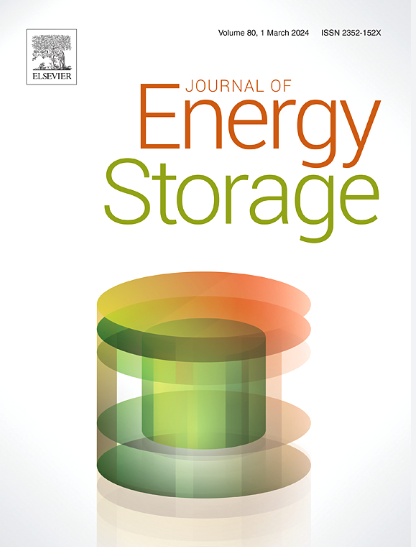电力-淡水多发电组合太阳能-储能系统:多目标粒子群优化的exgo -经济性评价
IF 8.9
2区 工程技术
Q1 ENERGY & FUELS
引用次数: 0
摘要
本研究评估了一种集成太阳能-储能系统,该系统由带开式进料加热器的有机朗肯循环(ORC- ofh)、带ORC的喷射器制冷循环(ERC-ORC)和反渗透(RO)子系统组成,旨在提高能源效率和淡水产量。利用能量和质量平衡方程进行系统建模,进行了努力经济评估,以分析投资回收期和净现值(NPV)。利用多目标粒子群优化(MOPSO)优化火用效率和最小化投资回报时间,重点研究蒸汽发生器温度、质量分数和喷射器主压力比对系统性能的影响。主要发现表明,太阳框架经历了最大的火用破坏(86%),ERC-ORC (8%), ORC-OFH(4%)和RO(2%)贡献较小。提高蒸汽发生器温度提高了总发电量和火用效率,同时降低了冷却负荷,从而将投资回收期从5.97年缩短到5.68年。此外,工作流体质量分数的变化揭示了影响工作性能和投资回收期的复杂相互依赖性。采用MOPSO算法优化了系统参数,有效效率为6.58%,投资回收期为5.11年。三种定价方案的NPV分析表明,价格波动显著影响了系统的可行性,价格下降50%导致NPV下降57.41%,投资回收期增加49.27%,而价格上涨将投资回收期缩短至4.79年。这项研究强调了优化集成太阳能系统的重要性,以提高性能和经济可行性。本文章由计算机程序翻译,如有差异,请以英文原文为准。
Integrated solar energy-energy storage system for an electricity-freshwater multigeneration configuration: Exergo-economic assessment with multi-objective particle swarm optimization
This study evaluates an integrated solar energy-energy storage system comprising organic Rankine cycle with open feed heater (ORC-OFH), ejector refrigeration cycle with ORC (ERC-ORC), and reverse osmosis (RO) subsystems aimed at enhancing energy efficiency and freshwater production. Utilizing energy and mass balance equations for system modeling, an exergo-economic assessment was performed to analyze payback period and net present value (NPV). Multi-objective particle swarm optimization (MOPSO) was utilized to optimize exergy efficiency and minimize payback time, focusing on the effects of vapor generator temperatures, mass fractions, and ejector primary pressure ratio on system performance. Key findings indicate that the solar framework experienced the maximum exergy destruction (86 %), with ERC-ORC (8 %), ORC-OFH (4 %), and RO (2 %) contributing less. Increasing vapor generator temperatures improved total power generation and exergy efficiency while reducing cooling loads, resulting in a reduced payback period from 5.97 to 5.68 years. Moreover, variations in working fluid mass fractions revealed complex interdependencies affecting exergetic performance and payback period. The implementation of the MOPSO algorithm optimized system parameters, achieving 6.58 % exergetic efficiency and a 5.11-year payback period. The NPV analysis across three pricing scenarios demonstrated that price fluctuations significantly impacted system viability, with a 50 % price reduction resulting in a 57.41 % decrease in NPV and a 49.27 % increase in payback period, while increased prices declined the payback period to 4.79 years. This research underscores the importance of optimizing integrated solar energy systems for enhanced performance and economic feasibility.
求助全文
通过发布文献求助,成功后即可免费获取论文全文。
去求助
来源期刊

Journal of energy storage
Energy-Renewable Energy, Sustainability and the Environment
CiteScore
11.80
自引率
24.50%
发文量
2262
审稿时长
69 days
期刊介绍:
Journal of energy storage focusses on all aspects of energy storage, in particular systems integration, electric grid integration, modelling and analysis, novel energy storage technologies, sizing and management strategies, business models for operation of storage systems and energy storage developments worldwide.
 求助内容:
求助内容: 应助结果提醒方式:
应助结果提醒方式:


